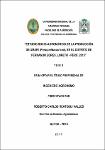Estudio socio-agronómico de la producción de umarí (Poraqueiba sericea), en el distrito de Fernando Lores, Loreto - Perú, 2015
Abstract
El presente trabajo de investigación se desarrolló en el Distrito Fernando Lores, en su capital Tamshiyacu – Ubicado a orillas del Río Amazonas, a 4 horas bote motor de la Ciudad de Iquitos. Cuya población basa su actividad en la agricultura, comercio y actividades de transformación de recursos del bosque, como base principal de su sustento se armoniza entre otras actividades de importancia como la caza, pesca, etc.
Analizar socio-agronómicamente el sistema de producción local del cultivo de Umarí (Poraqueiba sericea) en el distrito de Fernando Lores - Tamshiyacu, Loreto – Perú 2015.
El mayor porcentaje de agricultores posee 10 has de terreno pudiendo existir aquellos que poseen más de 50 Has., con una sub utilización del 60% ya que el porcentaje de área utilizada en la mayoría varía entre el 10 al 40%, entre una gran diversidad de cultivos entre frutales y maderables; entre ellos el Umari
El aspecto económico administrativo de los agricultores, estos basan su producción en una gran diversidad de cultivos y en diferentes épocas del año Umari, Piña, tumbo, entre otros cultivos en época de creciente así como la producción de carbón de umari por su precio en el mercado amenaza estos umarales ya que cada vez se usan plantas más jóvenes por la demanda local por el alto costo del gas en la ciudad y por los grandes comercios en la ciudad de Iquitos que amenaza no solo al umari incluyendo a otras especies entre ellas forestales; así mismo en épocas de vaciante el melón, sandía, hortalizas y arroz son otra actividad que desarrolla en agricultor; hoy en día el cacao en las parcelas ha generado una actividad que vienen conllevando a abrir nuevas parcelas con este cultivo.
El aspecto social y ambiental, se observa que gran parte de los agricultores entrevistados poseen umari en sus chacras ya en pequeñas extensiones. This research work was carried out in the Fernando Lores District, in the capital Tamshiyacu - Located on the banks of the Amazon River, 4 hours motorboat of the City of Iquitos. Whose population bases its activity on agriculture, trade and activities of transformation of forest resources, as the main basis of their livelihood is harmonized among other activities of importance as hunting, fishing, etc.
To analyze socio-agronomically the local production system of the Umarí (Poraqueiba sericea) crop in the district of Fernando Lores - Tamshiyacu, Loreto - Peru 2015.
The highest percentage of farmers has 10 hectares of land and there may be those with more than 50 hectares, with a 60% underutilization, since the percentage of area used in the majority varies between 10 and 40%, among a great diversity of crops between fruit and timber; among them the Umari
The economic administrative aspect of the farmers, these base their production on a great diversity of crops and at different times of the year Umari, Piña, tumbo, among other crops in time of increasing as well as the production of coal of umari for its price in the market threat these umarals as increasingly younger plants are used by local demand for the high cost of gas in the city and by large businesses in the city of Iquitos that threatens not only the umari including other species including forest, also in times of vaciante the melon, watermelon, vegetables and rice are another activity that develops in farmer; today the cacao in the plots has generated an activity that have led to open new plots with this crop.
The social and environmental aspect, it is observed that a large part of the farmers interviewed have umari in their farms and in small extensions.
Collections
- Tesis [673]
The following license files are associated with this item:


